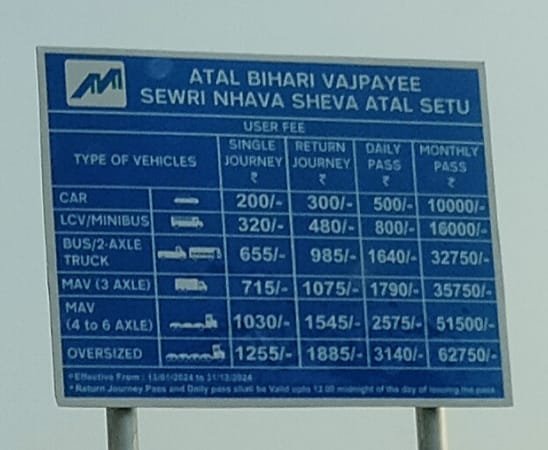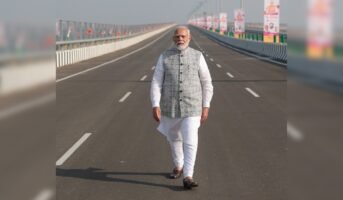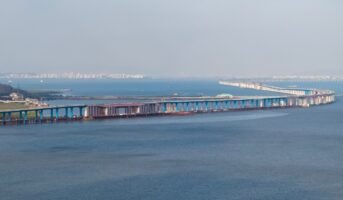Mumbai, the financial capital of India, has a population of over 1.24 crore and heavily depends on public infrastructure and transport such as local trains, monorail, Mumbai Metro and BEST buses for connectivity. With the city growing, Mumbai is undergoing a facelift when it comes to infrastructural development. One such infrastructure development is the development of the 21.8-km-long Mumbai Trans Harbour Link that connects Sewri to Navi Mumbai’s Chirle that is located along the JNPT Road. The sea link is developed by the Mumbai Metropolitan Region Development Authority (MMRDA). This is the longest bridge in India. The official name of the Mumbai Trans Harbour Link is the Shri Atal Bihari Vajpayee Trans Harbour Link.
The MTHL was inaugurated on January 12, 2023 by Prime Minister Narendra Modi. You can see the inauguration video here. The MTHL was scheduled to open to the public on December 25, 2023.
Mumbai Trans Harbour Link map

Source: JICA

See also: Upcoming expressways in India
MTHL toll charges
The Maharashtra government has set the toll tax for one way of travel on the MTHL by car at Rs 200. The toll will be reviewed and may be revised after one year of operations.

The government plans to collect toll tax for this sea bridge for around 45 years. The toll for one way when calculated with the Bandra Worli Sea Link as the benchmark came to more than Rs 500 which was considered to be on the higher side.
MMRDA, in 2012, had proposed toll rates for the Mumbai Trans Harbour Link as Rs 175 for cars, Rs 265 for LCV, Rs 525 for HCV and Rs 790 for multi-axle vehicles. However, due to increase in construction costs JICA, which is also the largest investor in the project, there has been an increase in the toll charges.
Mumbai Trans Harbour Link: Speed limit

In a statement issued by the Maharashtra Police, the MTHL will allow a maximum speed of 100 kmph for vehicles. The ascent and decent of the vehicles on the MTHL is 40 kmph.
Mumbai Trans Harbour Link: Vehicles allowed
| Vehicles allowed | Vehicles not allowed |
| Cars | Motor bikes |
| Taxis | Two -wheelers |
| Light Motor Vehicles | Three- wheelers, Auto rickshaws |
| Mini-buses | Vehicles drawn by animals |
| Two- axle buses | Tractors |
| Slow moving vehicles |
Mumbai Trans Harbour Link: Features
- The MTHL will feature an Open Road Tolling (ORT) system. With this, people do not have to slow down and pay the toll tax even while at 100 km per hour.
- The MTHL will have six lanes and is expected to handle around 70,000 vehicles.
- With the MTHL, time taken from Sewri to Chirle will be reduced to 15-20 minutes.
- Cameras based on artificial intelligence (AI) will be used to monitor the MTHL.
- In case of breakdowns, authorities can tow the vehicles through emergency lane.
- With the MTHL the time taken to travel to Pune from Mumbai will reduce by 1.3 hours from the already 3 hours and the time taken to travel to Goa will reduce from 11 hours to 9 hours.
Mumbai Trans Harbour Link: Construction details
MMRDA successfully launched the first longest Orthotropic Steel Deck (OSD) of around 22 km in package-2 of MTHL on January 11, 2023. The first longest OSD of package-2 between Mumbai and Navi Mumbai is 180 metres long and weighs 2,300 metric tonnes. MTHL has launched 15 spans already of the 32 OSD spans that the MTHL package-2.
By December 2022, 90% of the work on the Mumbai Trans Harbour Link was complete. Work on connector ramps and interchange loops that connect nearby roads to the main bridge had started.
The longest bridge in India, the Mumbai Trans Harbour link will be a six-lane expressway that will start at Sewri, cross the Thane creek and end at Chirle near Nhava Sheva. The Nhava Sheva sea link is also the 12th longest bridge in the world. Design and plan of the Mumbai Trans Harbour Link has similarities to the King Fahd Causeway in Saudi Arabia (26 km) and Hangzhou Bay Bridge in China (36 kms). Once completed, the trans harbour link will be the longest sea bridge in India and would be catering to 70,000 vehicles on a daily basis. Of the 22 km long Mumbai Trans Harbour Link, 16.5 km is above the sea.
While the Mumbai Trans Harbour link project was planned the 1990s, it encountered many roadblocks. The Sewri Nhava Sheva sea link project was revived in 2016 with prime minister Narendra Modi laying the foundation stone. In April 2018, construction work started on the Mumbai Trans Harbour Link, which was divided into three packages.
The first package is 10.38 kms from Sewri to Thane creek and is being developed by L&T and IHI Corporation. The second package is of 7.807 kms from Thane Creek to Shivaji Nagar, being developed by Tata Projects and Daewoo E&C. The third package is 3.613 kms that is being developed by L&T and will connect the Mumbai Trans Harbour link with state highways 52 and 54 and national highway 4B at Chirle, Navi Mumbai.
The fourth package of the Mumbai Trans Harbour Link is the Intelligent Transport Systems (ITS) that includes MTHL Toll and Transport Management System and Equipment Installation for the Project.
As on September 22, 2023, the MTHL is the project is currently
on track, with a completion rate of 96.60%.
See also: All about Water Taxi Mumbai – Navi Mumbai ferry service
Mumbai Trans Harbour Link: Quick facts
- 1,70,000 metre tonne of steel bars used in the longest bridge in India-MHTL which is the weight of 17 Eiffel towers.
- Around 35 km pile liners used which is 35 times taller than Burj Khalifa
- 9,75,000 cubic metre of concrete used which is 6 times the concrete used in the Statue of Liberty.
Source: Devendra Fadnavis twitter
Mumbai Trans Harbour Link construction cost
Expected to be completed by 2023, the Mumbai Trans Harbour Link will be the longest sea link/ longest bridge in India. The construction cost of the Mumbai Trans Harbour Link is estimated to be around Rs 17,843 crore. Initially set to be built under the PPP model, the MMRDA later changed the model and executed the Mumbai Trans Harbour Link as an EPC model – Engineering, procurement and construction basis model. Around 85% of the project cost is financed by Japan International Cooperation Agency (JICA). Tanaka Akihiko, president, JICA with other delegates visited India’s longest sea bridge MTHL on March 16, 2023, to inspect the construction.
“MTHL is an ambitious civil project of India. The proposal of MTHL project was under consideration for about more than 30 years. Now MMRDA is executing this project with the help of the government and the financial support by JICA. Mumbai Trans Harbour Link (MTHL) a 6 lane access-controlled sea bridge with a route alignment connecting Sewri in south Mumbai and with Chirle in Navi Mumbai, will be the new gateway to Mainland. After completion of this project, Mumbai will be no longer
considered as island city. MMRDA is keen to provide safe and world class infrastructure to citizens,” said S.V.R. Srinivas, IAS, metropolitan commissioner, MMRDA.
Check out: Kamothe pin code
Mumbai Trans Harbour Link design
According to the design of the Mumbai Trans Harbour Link, the Mumbai end will have a three-level interchange that will connect to the Eastern Freeway and the Sewri-Worli connector. In this longest bridge in India, there will be an interchange at Shivaji Nagar and Chirle on the Navi Mumbai end.
In the middle of the concrete Mumbai Trans Harbour Link, there will be a steel span of four kms that will allow easy movement of ships to the JNPT below the Mumbai Trans Harbour Link. The Mumbai Trans Harbour Link will also have view barriers at the Bhabha Atomic Research Centre (BARC) and noise barriers at Sewri mudflat area, which is a safe haven for migratory birds and flamingos.
The Mumbai Trans Harbour Link will also include amenities including an intelligence transport system (ITS) and variable message signs that are very important for a sea link. The maximum speed limit on the Mumbai Trans Harbour Link will be restricted to 100 kmph. Traffic on the Mumbai Trans Harbour Link will be managed using CCTV cameras by the Mumbai traffic control centre.
The Mumbai Trans Harbour Link will have a bird watching platform to view flamingos and other migratory birds. The MMRDA has built a 5.6-km temporary bridge for transporting equipment and people working on the project and this will be converted to a bird watching platform. This will be advantageous to the MMRDA, as it will save the cost of demolishing the bridge.
See also: All about the Navi Mumbai Airport project
As part of the MTHL project, a total of 1212 lighting poles will be installed, with approximately 20% already in place as on September 22, mentioned a MMRDA statement. These poles are equipped with a Central Control & Monitoring System (CCMS) and have been specifically designed to withstand the challenges of being situated in the deep sea.
Notable features of these poles include their suitability for saline environments, corrosion-free polyurethane coating, galvanisation to prevent rust and prolong lifespan, structural design to withstand high wind velocities and uniform illumination throughout the bridge. Additionally, the street lighting poles will be equipped with a Lightning Protection System to safeguard against potential damage caused by lightning.
Mumbai Trans Harbour Link: Land acquisition
For the development of the Mumbai Trans Harbour Link, close to 130 hectares of land is required, of which CIDCO has contributed around 88 hectares. As the remaining land is private land, the MMRDA will compensate owners for the same. The MMRDA will receive around 27 hectares of land from Mumbai Port Trust.
Mumbai Trans Harbour Link: Advantages
- Alternate route between Mumbai and Navi Mumbai thus resulting in reduction in travel time between Navi Mumbai and Mumbai city and decongesting the city.
- Positive impact on Navi Mumbai’s real estate market.
- Improved connectivity between Mumbai Port Trust and JNPT port.
- Connectivity to Mumbai Pune Expressway.
Know about: Nerul pin code
Mumbai Trans Harbour Link: Real estate impact
The inauguration of the MTHL in addition to bringing Mumbai and Navi Mumbai closer with travel times reduced to 20 minutes has also brought in a positive impact on the real estate segment in the market. While nodes in Navi Mumbai such as Ulwe was already showing a promising growth, the demand in residential reality here has seen a spike with the MTHL in its vicinity. Additionally, with the government looking at developing Third Mumbai and the Navi Mumbai International Airport also to be a reality soon, experts believe that Navi Mumbai residential market is on the growth path. What is worth mentioning is that while there is an increase in demand, this is also being fulfilled by presence of reputed developers who are developing gated communities predominantly.
Conclusion
Mumbai city has always been known for its strong infrastructure and use of public transport. With the inauguration of the Mumbai Trans Harbour Link, the sea has been effectively used in this island city. The city which is also known for its traffic jams has walked its way in decongesting a very important route- Mumbai to Navi Mumbai. With public transport also stepping in, the Trans harbour link will be more effectively used. This will indirectly impact real estate prices in areas around the MTHL. If you are scouting for properties in Navi Mumbai, the Ulwe, Kharkhopar, Belapur, Nerul belt is worth exploring. These areas will further see a surge with the Navi Mumbai International Airport also planned to be operational by December 2024.
Mumbai Trans Harbour Link: Latest news
February 14, 2024:
NMMT introduces bus services on Mumbai Trans Harbour Link
Four bus services of bus number 115 between Nerul and Mantralaya will be started by the Navi Mumbai Municipal Transport (NMMT) on the Mumbai Trans Harbour Link. The route will cover Nerul, Kharkopar, Ulwe and Mantralaya. The NMMT will not be revising the fare and will retain the existing fare of Rs 90 for this AC bus that will now cover 52 km. The services will start next week. NMMT is still to receive clarity on if the public transport will have to pay the toll or will it receive any kind of waiver. Additionally, a special bus route -( s-145) has been introduced by the BEST bus on the Mumbai Trans Harbour Link.
December 12, 2023:
Ulwe Coastal Road to connect MTHL with Navi Mumbai International Airport
In a bid to provide connectivity to the Navi Mumbai International Airport , Cidco will construct the Ulwe Coastal Road that will connect the Mumbai Trans Harbour Link with the Navi Mumbai International Airport. With this in place, travel time between Navi Mumbai and Mumbai will be reduced significantly. While approval was given by the MCZMA) on August 10, 2023, Cidco is waiting for permissions from the Bombay High Court to commence the construction. Cidco has appointed J Kumar- JMM contractors for the construction of this project.
FAQs
What is the new name of MTHL?
As per media reports, the MTHL has been named as Atal Bihari Vajpayee Smruti Sewree Nhava Sheva Atal Setu
What is the cost of MTHL?
The project cost of MTHL is around Rs 17,843 crore.
Who is constructing MTHL?
L&T and Tata Projects are constructing the MTHL.
What are the benefits of MTHL?
MTHL will enhance connectivity between Navi Mumbai and Mumbai and thus to JNPT and NMIA.
Is MTHL toll free?
No, the MTHL will have the ORT system in place where toll will be connected without having traditional toll booths.
Which is the largest sea link in India?
The Mumbai Trans Harbour Link is the largest sea link in India.
Will MTHL connect to Mumbai Pune Expressway?
The MTHL will connect the Mumbai-Pune Expressway via an elevated corridor.
By when will the Mumbai Trans Harbour link project be completed?
The Mumbai Trans Harbour Link project is expected to be completed by 2023.

With 16+ years of experience in various sectors, of which more than ten years in real estate, Anuradha Ramamirtham excels in tracking property trends and simplifying housing-related topics such as Rera, housing lottery, etc. Her diverse background includes roles at Times Property, Tech Target India, Indiantelevision.com and ITNation. Anuradha holds a PG Diploma degree in Journalism from KC College and has done BSc (IT) from SIES. In her leisure time, she enjoys singing and travelling.
Email: [email protected]











